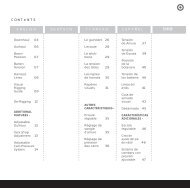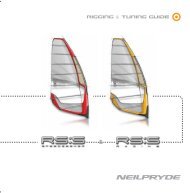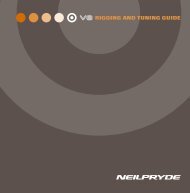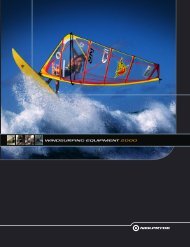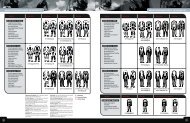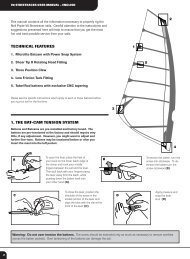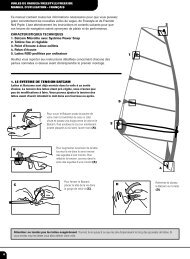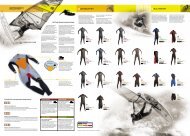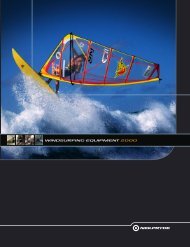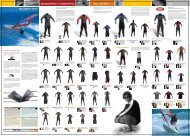Neil Pryde RAF Supersonic User Manual
Neil Pryde RAF Supersonic User Manual
Neil Pryde RAF Supersonic User Manual
You also want an ePaper? Increase the reach of your titles
YUMPU automatically turns print PDFs into web optimized ePapers that Google loves.
<strong>User</strong> <strong>Manual</strong>
<strong>Neil</strong> <strong>Pryde</strong> <strong>RAF</strong> <strong>Supersonic</strong><br />
<strong>User</strong> <strong>Manual</strong><br />
2<br />
This manual contains all the information necessary to properly rig the<br />
<strong>Neil</strong> <strong>Pryde</strong> <strong>RAF</strong> <strong>Supersonic</strong>. Careful attention to the instructions<br />
presented here will help to ensure that you get the most fun and best<br />
possible service from your sails.<br />
TECHNICAL FEATURES<br />
1<br />
1. Batcam III with Power Snap System<br />
2. Shear Tip Rotating Head Fitting<br />
3. Two position clew<br />
4. Low Friction Tack Fitting<br />
5. Tube/Rod battens with exclusive CNC tapering<br />
5<br />
Please see the specific instructions which apply to each of these<br />
features before you rig your sail for the first time.<br />
3<br />
1. THE BAT-CAM TENSION SYSTEM<br />
Battens and Batcams are pre-installed and factory tuned. The<br />
battens are pre-tensioned at the factory and should require very<br />
little, if any adjustment. However, you might want to adjust and<br />
further fine-tune. Battens may be tensioned before or after you<br />
insert the mast into the luff pocket.<br />
4<br />
A<br />
To open the lever, place the heel of<br />
your hand on the lower leech edge of<br />
the clamp and hook your middle<br />
fingers between the sail and the lever.<br />
Then pull back with your fingers prying<br />
the lever away form the leech, while<br />
pushing down the batten itself with<br />
your other hand (A).<br />
B<br />
To tension the batten, turn the<br />
screw anti-clockwise. To detension<br />
the batten turn the<br />
screw clockwise (B).<br />
C<br />
To close the lever, position the<br />
shoulder of the screw in the<br />
socket portion of the lever and<br />
align the tube with the clip at the<br />
front of the lever (C).<br />
D<br />
Apply pressure and<br />
snap the lever<br />
shut (D).<br />
Warning: Do not over tension the battens. The screw should be extended only as much as necessary to remove wrinkles<br />
across the batten pockets. Over tensioning of the battens can damage the sail.
2<br />
3<br />
TWO POSITION CLEW<br />
THE SHEAR TIP FITTING<br />
Before inserting the mast, make sure that you have installed<br />
the correct mast tip plug for the Shear Tip Rotating Fitting.<br />
This plug is supplied with the sail (in the sail bag pocket). You<br />
will need to remove the plug which is currently in the tip of<br />
your <strong>Neil</strong> <strong>Pryde</strong> mast and replace it with the correct mast tip<br />
plug for the Shear Tip Rotating Fitting. After inserting the mast<br />
into the sail, take care that the fitting is seated correctly in the<br />
socket. Once the rig is tensioned, you may adjust the tension<br />
on the Shear Tip sleeve using the Tip adjuster screw, but only<br />
until smooth. Do not over tension.<br />
Note: The Shear Tip Fitting has been designed in such way<br />
that it is possible to push down the tip of the arm (see<br />
diagram), eg when the tip catches a rock or the ground.<br />
When pushed down, the tip will automatically spring back to<br />
its initial position.<br />
Select the clew ring that’s best suited to your requirements. Most sailors like the boom to be<br />
roughly perpendicular to the mast, so start by setting the clew according to your preferred boom<br />
height; then adjust according to mast rake, wind conditions, and your own sailing style. One tip is<br />
to use the highest hole in light winds and/or very smooth water conditions to develop the best<br />
power. Use the lower hole when overpowered or in rough water when you want to tune the sail<br />
flatter without closing off the twist.<br />
4<br />
A<br />
D<br />
B<br />
LOW FRICTION TACK RING<br />
The Low Friction Tack Fitting must be rigged<br />
properly to ensure maximum downhauling<br />
efficiency. Always rig the tack fitting according<br />
to the diagram.<br />
C<br />
RIGGING<br />
A. Set your boom and mast base to the dimensions printed<br />
near the tack. The sail is designed to be perfectly trimmed on<br />
the correct mast at the recommended settings.<br />
B. Check that all the battens are fully inserted into their<br />
pockets. The battens are pre-tensioned at the factory and<br />
should require very little, if any adjustment.<br />
C. Insert the mast into the luff pocket working the sail down<br />
the mast a bit at a time. When you have the mast almost all<br />
the way in, use the tack handle to help pull the remaining<br />
distance to the mast base.<br />
D. Thread the downhaul line according to the instructions<br />
and partially tension the luff using the low friction tack fitting.<br />
E. Attach the boom to the mast, allowing space above it in<br />
the cut-out so that the sail can be fully downhauled later.<br />
F. Downhaul the sail to approximately 1cm above the cleat<br />
base as shown in diagram. Fine-tune<br />
around this position. A small sticker has<br />
been provided with your sail which you can<br />
wrap around your mast base and use as a<br />
reference when you find your best tuning.<br />
All 1998 <strong>Neil</strong> <strong>Pryde</strong> mast bases already<br />
carry this trim zone. When in the correct<br />
tuning range, the tack pulley will be as<br />
shown.<br />
G. If necessary, re-tension the battens until wrinkles at the<br />
batten pockets disappear. Be sure not to over-tension the<br />
battens.<br />
H. Adjust the outhaul to the recommended dimensions<br />
and make the boom length so the clew is within two<br />
centimeters of the boom end. Use a tape measure to<br />
ensure accuracy and repeatability of the settings.<br />
I. To ensure correct tuning for your specific sail, please<br />
consult the trim instructions that follow:<br />
RIGGING TIPS<br />
Pure <strong>RAF</strong> sails have no cams, so putting the mast into the<br />
luff pocket is easy. Grab the sail by using the handle<br />
located inside the fairing.<br />
DE-RIGGING<br />
A. Be sure that the tack fairing is clear of the mast base<br />
rings and other rig components.<br />
B. Carefully ease the outhaul until it is completely loose.<br />
C. Remove the boom.<br />
D. Carefully release the downhaul a little at a time.<br />
E. Remove the mast.
SAIL MAINTENANCE<br />
Always store your sail rolled and dry in its sailbag. Try to prevent the sail from<br />
being crushed or badly creased. Wash the sail in fresh water after use if<br />
possible, but do not store wet. The battens may be left in their pockets.<br />
Do not leave the sail exposed to strong or direct sunlight.<br />
Do not use any solvents or chemicals to clean it. If the sail becomes dirty, use<br />
fresh water and mild soap.<br />
Make sure that you always keep the Shear Tip Rotating Head Fitting as free of<br />
sand as possible and flush the head area and fitting with fresh water regularly.<br />
SAIL SAFE, HAVE FUN<br />
Sail carefully and thoughtfully around other sailors and beach users.<br />
Before leaving the beach check all your equipment thoroughly for<br />
signs of wear or breakage. Always check the weather forecasts and<br />
take note of local conditions and potential hazards before sailing.<br />
Check for dangerous currents, and consider carefully where you<br />
might land in the event of an emergency.<br />
For further information on this or other NEILPRYDE windsurfing<br />
equipment contact your AUTHORISED NEILPRYDE DEALER or our<br />
distributor in your country.<br />
TUNING THE <strong>RAF</strong> SUPERSONIC<br />
First set the sail to the base recommendations printed at the sail tack. Then, if necessary, tune the downhaul<br />
so that the leech appears just loose at the first and second batten. There may be some small wrinkles in the<br />
edge of the leech down to the first batten but these should not look pronounced or extreme. There will be<br />
looseness of the sail material inboard from the batten ends down to the batten #2 or #3 but this will not be<br />
wrinkled looking nor will the edge of the sail be heavily wrinkled in this area. Once the upper leech looks<br />
correct (see drawing), then add outhaul until the leech makes a straight line from the first batten above the<br />
boom right up to the head. This should normally require between 2–4cm of “positive” outhaul (beyond the<br />
point where you start to feel resistance). If in doubt add an additional 5–10mm to be sure the sail is<br />
sufficiently outhauled.<br />
When softness edge is in the<br />
middle of the Trim Zone<br />
Ideal Downhaul<br />
Moderate Wind<br />
Examples of correctly tuned<br />
racing sails.<br />
A NOTE ON RIG DIMENSIONS<br />
The rig dimensions printed on the tack of all <strong>Neil</strong> <strong>Pryde</strong> collection sails<br />
show the following information:<br />
■ Base setting: this is the number which you should set your <strong>Neil</strong><br />
<strong>Pryde</strong> aluminum or carbon mast base ring. Rigged on the correct mast<br />
you will be able to downhaul perfectly with the carbon base. You will<br />
have to interpolate the setting for using the aluminum base since the<br />
dimensioning is different.<br />
■ Boom dimension is stated as the best average tuned dimension plus<br />
or minus 1 cm. This is measured from the forward edge of the mast (at the<br />
center of the boom cutout) to the sail clew at the center eyelet.<br />
These figures are intended as a GUIDE to proper sail trim and depending<br />
on the rig components you choose may not always correspond perfectly to<br />
the settings which are best for you.<br />
CHOOSING THE RIGHT MAST<br />
Every <strong>Neil</strong> <strong>Pryde</strong> sail is designed around a specific recommended mast.<br />
To get the optimum performance from your <strong>Neil</strong> <strong>Pryde</strong> sails, use the<br />
recommended mast. In many cases an alternative mast is specified and<br />
this will also provide good performance. For a lighter and more<br />
responsive feel, you can choose to use the upgrade masts which are<br />
often specified.



